Pennsylvania Partnerships Place High-RAP Mix
BY AsphaltPro Staff
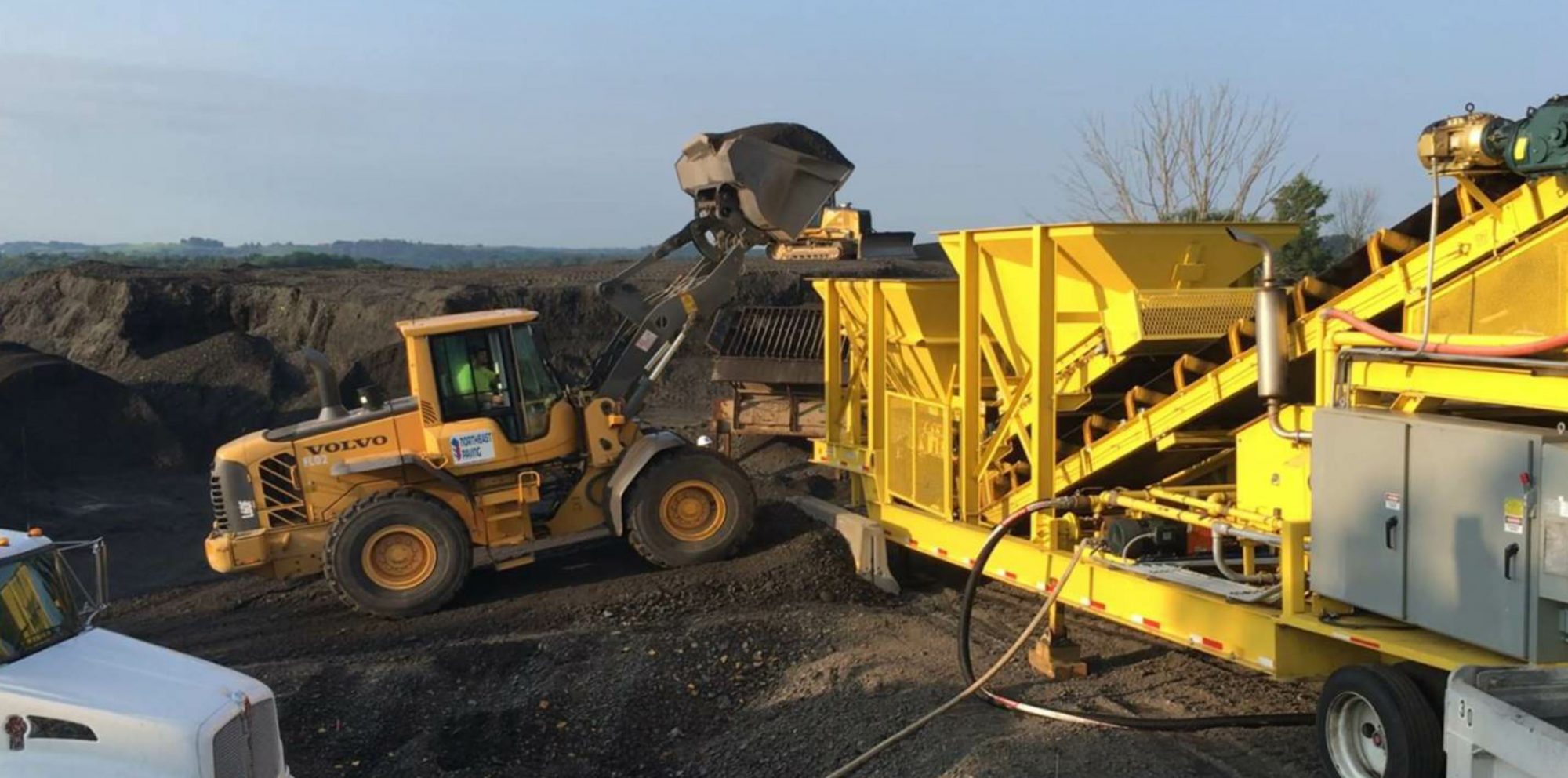
When Northeast Paving, Pittsburgh, Pennsylvania, won a bid to repave a few miles on Interstate 70, the company also agreed to take on a unique project alongside the Pennsylvania Department of Transportation on SR3021 and 3021, more commonly known as Old Brick Road.
These so-called hybrid projects—of which Old Brick Road is the first—aim to solve a number of challenges. They will allow PennDOT to use its abundant reclaimed asphalt pavement (RAP) stockpiles, free up DOT resources and staff for maintenance projects, and allow roads that would likely go unrepaired to be repaved. Hybrid projects also open up these jobs, which would normally be performed by DOT staff, to paving contractors.
“The real benefit of hybrid jobs is that they don’t tie up equipment, manpower, and other PennDOT resources,” said Scott Young, Special Advisor for Strategic Transportation Initiatives for PennDOT. “This hybrid approach provides us an opportunity to get this work done when department resources aren’t available. All it requires from us is the pugmill and operator.”
Young has been with PennDOT for nearly 40 years, and has been involved in RAP for almost his whole career.
“Now, I’m trying to migrate those best practices throughout the commonwealth,” Young said. “Hybrid projects like this are our attempt to do that, think outside of the box, and help districts and counties expand their recycled asphalt programs.”
Migrate Best Practices
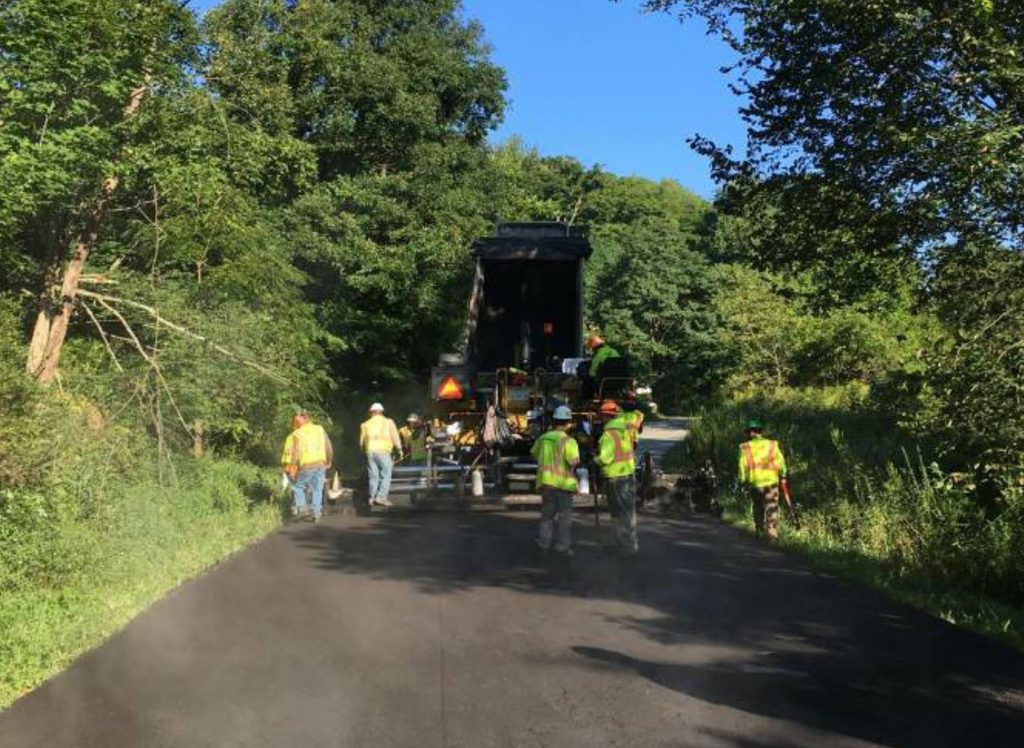
PennDOT partnered with Northeast Paving to place high-RAP mix on Old Brick Road.
The hybrid project for which PennDOT worked alongside Northeast Paving was located in southwest Pennsylvania, in Engineering District 12.
“Old Brick Road was in need of paving, but there wasn’t enough money to repave it out of the county budget,” Young said, “so the stars aligned.”
The project, located in district 12’s Washington County, was funded through PennDOT’s central office so it could be done at no cost to the county.
Old Brick Road is a rural, low volume commercial road that fit the criteria PennDOT has for jobs of this type: a maximum average daily traffic count of 3,000 with less than 10 percent truck traffic.
It was also located adjacent to its RAP source, I-70, which Northeast Paving milled before trucking the materials to the yard PennDOT would be using to store stockpiles and produce mix with its Pugmill Systems portable pugmill plant.
According to Northeast Paving Superintendent Ralph Tedesco, trucking material to the stockpile site was a big job to coordinate. In total, they hauled 23,280 tons of RAP and 89,207 gallons virgin asphalt cement (AC) to the stockpile site (an average of three tankers per day).
Once they had built a decent-sized pile of 12,000 tons, Northeast began screening the RAP through a 2-inch sieve shaker. Operating with multiple piles of RAP in a smaller space than usual presented a challenge to overcome.
“If we had to do it all again, I think we’d bring in a crusher and crush the material all down into one pile, rather than having a milling pile, a good pile, and a bad pile,” said Northeast Paving Superintendent Scott Kuhn. “We had a very small area to work with.”
However, it wasn’t long before the mix was on its way to the paving crew on Old Brick Road.
The Pugmill Systems plant can produce up to 400 tons of cold mix per hour. On this job, the plant averaged around 240 tons per hour, which was then loaded into Northeast Paving haul trucks and taken to the paving crew on Old Brick Road.
“From the screened pile, it was only 35 or 40 minutes until we were placing that mix with the paver,” Tedesco said.
Although the Old Brick Road hybrid project involved Northeast Paving to perform the milling, crushing, hauling and paving, Young said each hybrid project could take a slightly different form. “Perhaps sometimes the contractor will provide crushing, trucking and placement, sometimes they might only do placement,” Young said. “It also opens the box for us to think about things in a different way.”
The Core of Concept
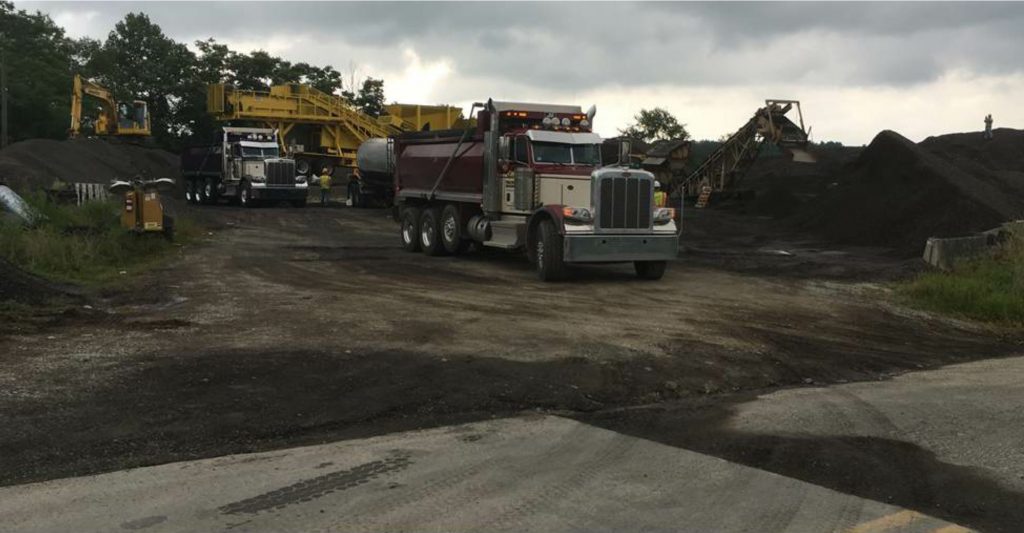
On this job, the plant averaged around 240 tons per hour, which was then loaded into Northeast Paving haul trucks and taken to the paving crew on Old Brick Road.
PennDOT purchased three Pugmill Systems plants to help it achieve its goal of including RAP in more projects at higher percentages while keeping quality top of mind. It plans to purchase a third pugmill in the coming year.
All of the DOT’s pugmills are shared among Pennsylvania’s 12 engineering districts.
According to Young, the six counties that make up District 1, in northwest Pennsylvania, have been using pugmills for the last 35 years. Six of the districts have already begun paving with RAP on around 60 different projects.
Young estimates that the DOT places an average of 100,000 tons of this high-RAP mix per year. Although all of those jobs were internal DOT jobs, Young expects that to change as the DOT implements this hybrid project concept piloted in District 12.
“Based on [the Old Brick Road] project, I’m sure folks in other districts will reconsider how they do high-RAP paving jobs, moving forward,” Young said.
District 12 is not only new to the hybrid project concept, but also to the process of using pugmill to produce high-RAP mixes. Transportation Equipment Operator Specialist Dave Demyanovich visited District 12 to teach local DOT staff how to set up, calibrate, and use the pugmill. Demyanovich has been running machines like this for 13 years and is the Commonwealth’s subject matter expert.
“This type of project was unfamiliar to us and to this district,” Kuhn said. “We like to try new things and it was interesting to see how the guys from Erie County [in District 1] were doing this. The Erie were really nice to work with and knew the equipment really well.”
The experience employees from Erie County brought to the table also helped PennDOT specify their Pugmill Systems plants to suit their specific needs.
According to Jared Allen, vice president of Pugmill Systems, Columbia, Tennessee, PennDOT came to the table with a handful of well thought-out changes to make to the machine.
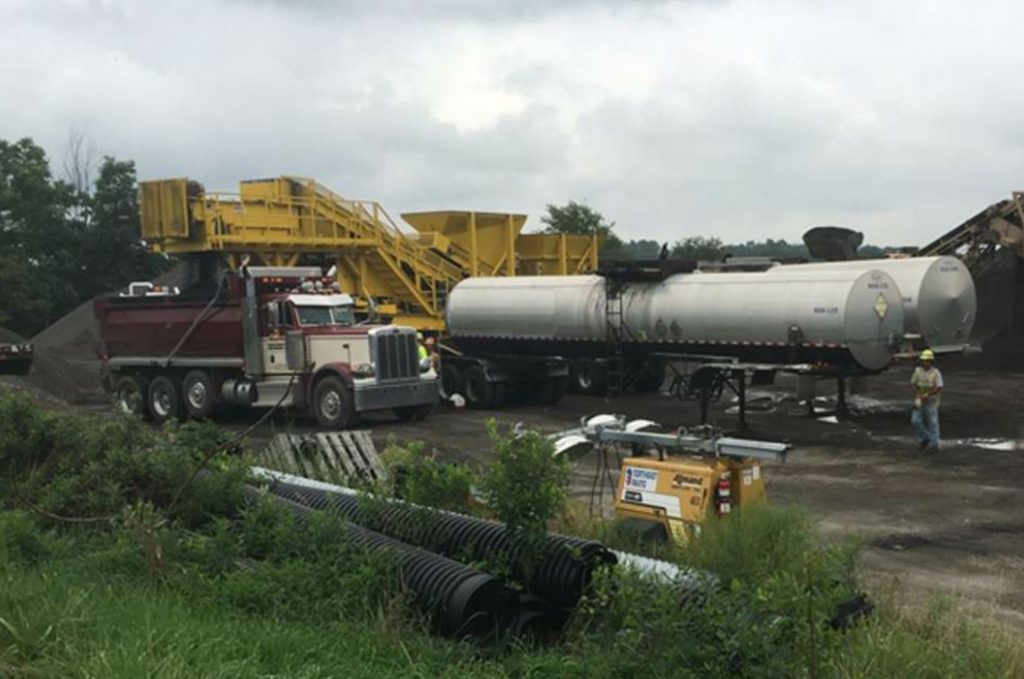
In addition to using up RAP stockpiles and repave roads that would otherwise go unrepaired, the hybrid method frees of PennDOT resources for other projects, since hybrid projects such as this one only require the pugmill and one operator from PennDOT.
For example, PennDOT wanted the machines’ parts to be ones that their maintenance division already had in stock. They also added specific safety stickers and textured paint to prevent slips and falls, mounted fire extinguishers in specific locations, and added a duplicate control system.
There are the touch screen controls, as usual, and then a manual set of controls in case, for any reason, the primary controls were to go down.
“We were excited to work with PennDOT on this project because it makes a lot of sense,” Allen said. “It’s fun for our people to build custom plants, especially for someone who has experience and knows what they want.”
“[Pugmill Systems] was really accommodating with the add-ons we asked for and helped us work through design issues,” Young said.
The pugmill PennDOT used can be used to produce a cold mix asphalt product with either recycled asphalt, virgin aggregate, or a combination of the two.
PennDOT performs a compatibility study with the RAP material that will be overlaid on the low-volume road. “We keep track of each pavement’s history at PennDOT,” Young said. “We also take samples and create parallel mix designs to make sure we’re on the right track.”
In some instances, they will use some virgin aggregate (usually 57s or 67s) alongside the RAP to add structure. The Old Brick Road, which required 10,500 tons of RAP in total, did not require the addition of virgin aggregate. Excess millings from I-70 were stocked for other PennDOT work.
PennDOT added 9.8 gallons of E8 oil and 1 to 1.5 gallons of water per ton. This resulted in a working temperature range for placement between 90 and 150 degrees Fahrenheit.
Pave Past Challenges
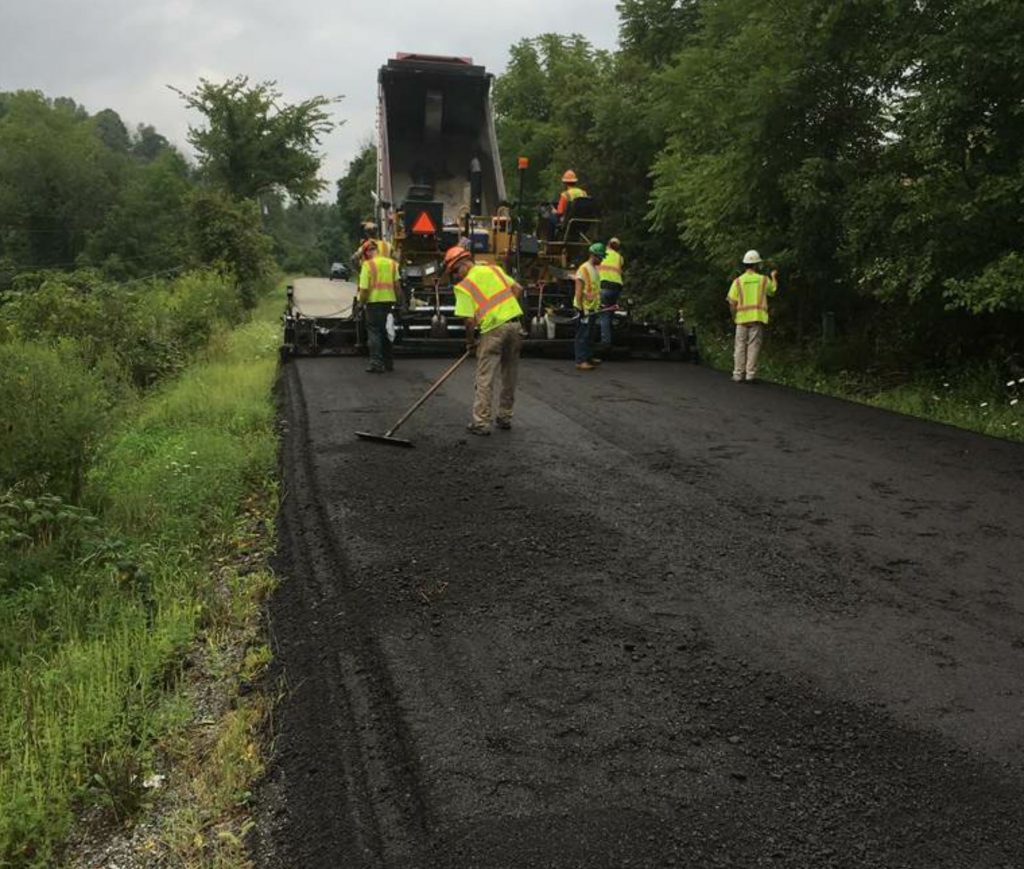
The hybrid project for which PennDOT worked alongside Northeast Paving was located in southwest Pennsylvania, in Engineering District 12.
Paving with this 100 percent RAP mix was quite normal, Tedesco said. What was unique, however, was the layout of the job.
The low volume road would not be wide enough for trucks to pass each other and back up as usual. Sometimes, Tedesco said, trucks had to back up for a mile and a half to get to the paver.
The width of the road also prevented traffic from passing in one lane as the other was paved. Since the entire road had to be closed anyway, both PennDOT and Northeast Paving thought it would be best to pave the 23-foot-wide road in one pass.
“If we hadn’t, I couldn’t imagine the mess haul trucks backing up that far might leave on the side of the road that had already been paved,” Tedesco said.
The Northeast Paving crew used a Caterpillar 1055 paver, which can go out to 19.6 feet wide, and they added 2-foot extensions with auger extensions on each side so they could pave the entire road in a single pass at a depth of 4 inches.
“We were paving so much mix that we needed a new truck every 50 feet,” Kuhn said. Then, that truck would need to pull out and another truck would need to back up to meet the paver.
How the mix came out of the dump truck presented another challenge.
“Normally, mix starts to flow out when the truck gets one quarter of the way up,” Tedesco said, “but with this mix, the trucks had to get about halfway up before it would start trickling out. What we found was that the beds should be raised halfway up and once it begins to flow, the bed should be dropped back down to avoid overflow.”
The rolling process was also a bit different.
“For this asphalt, you want it to set up a bit before rolling it,” Kuhn said. The two Caterpillar 435 rollers needed to stay around 45 minutes behind the paver. Otherwise, it may bring [binder] to the top of the mat and create a bleeding problem. “Staying that far back can be difficult for roller operators who are used to being right behind the paver, so it’s a bit of a learning process.”
Due to the nature of the mix, the 6-foot wide rollers tended to create creases that were rolled out in subsequent passes. The rolling pattern that PennDOT helped them establish included four passes with two Hamm steel drum rollers and two passes with a rubber tire roller.
For this type of job, PennDOT also taught the crew the importance of using a non-nuclear gauge because it can measure the moisture in this type of mix.
Two months after the road was paved, Northeast crews applied a chipseal to ensure the road was sealed up prior to winter and prevent chlorides from infiltrating the mat.
“We ended up with a great product,” Young said. “The road looks great. I ran this road several times after it was paved and the mat looked fantastic.” Based on the project’s success, Young said the concept will likely be expanded statewide.
PennDOT has a long-range plan to identify low-volume roads like Old Brick Road that meet its criteria for high-RAP mixes and are located near capital projects that could supply RAP. The plan also aims to identify the RAP network in each county and outline how much material is required on each qualifying job. Currently, the state has more than 1 million tons of clean RAP available.
“District 12 has a lot of rural roads like this one, so if it holds up with the traffic on it, I think this will become something they do a lot,” Kuhn said. “It’s a great way to get rid of millings.”
